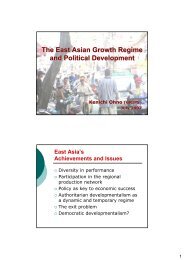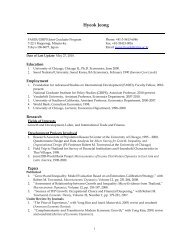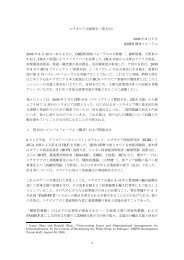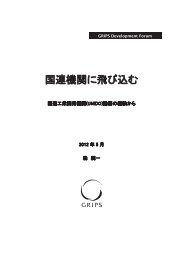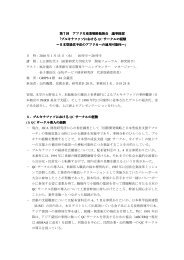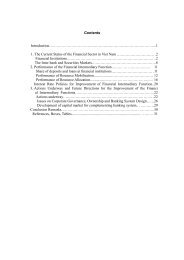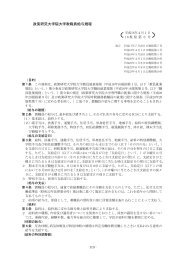lagged dependent variables. Probit with fixed effects is difficult to compute and may render estimatedcoefficients and statistics <strong>in</strong>consistent, especially <strong>in</strong> the case when large panel is not available. Probit withrandom effects fits better to specification with lagged dependent variables, if the problems caused by theassumption of uncorrelated relation between error term and <strong>in</strong>dependent variables are acceptable [Helmersand Trofimenko (2007)]. Roberts and Tybout (1997) use Heckman’s (1981a) dynamic random-effects probitestimator with b<strong>in</strong>ary-choice model. Although this approach has a drawback due to the assumption usuallyseen <strong>in</strong> random effects models, it is plausible <strong>in</strong> models of short panel with lagged dependent variables andthe proper treatment of dynamic decision process with <strong>in</strong>itial conditions controlled. In many other papers, <strong>in</strong>order to avoid the treatment of lagged dependent variables, researchers try to alleviate sunk cost variable outof their model, by simply ignor<strong>in</strong>g it or us<strong>in</strong>g no-status-switcher subsample. Arnold and Huss<strong>in</strong>ger (2004) usea probit model <strong>in</strong> a subsample of firms with persistent export behavior, argu<strong>in</strong>g that it helps exclude thelagged dependent variable <strong>from</strong> the set of explanatory variables, enable them to abstract <strong>from</strong> the effect ofentry costs to check for the robustness of the effects of the rema<strong>in</strong><strong>in</strong>g explanatory variables.Concern<strong>in</strong>g the potential simultaneity problems caused by the existence of two-way relationshipbetween export<strong>in</strong>g behaviors and characteristics of firms, econometric theories suggest the use ofsimultaneous equation models. However, the difficulty <strong>in</strong> fac<strong>in</strong>g with the identification condition h<strong>in</strong>ders theuse of this approach. Actually, it is not easy to f<strong>in</strong>d sufficient <strong>in</strong>strumental variables to estimate thesimultaneous equation system <strong>in</strong> a firm-<strong>level</strong> data. One approach frequently used by almost all the research <strong>in</strong>this literature is to lag all firm characteristics by one period. This elim<strong>in</strong>ates the possible effect of exportstatus to firm characteristics, help<strong>in</strong>g to analyze the other direction of effects, i.e., the determ<strong>in</strong>ants ofexport<strong>in</strong>g behavior.Tak<strong>in</strong>g the above-mentioned discussion, our purpose and data characteristics <strong>in</strong>to consideration, wechoose estimation specifications as follows. In order to illustrate differences between exporters andnon-exporters, we derive exporter premium across a range of characteristics: revenue, productivity, size, <strong>in</strong>put<strong>in</strong>tensity, labor skill and age. First, we do that by runn<strong>in</strong>g simple regression of each of these characteristics onexport status of firms to f<strong>in</strong>d and test simple exporter premium at the mean <strong>in</strong> the pooled data set as follows:ln Z + u*it = α 1Yitit(12)*where i <strong>in</strong>dexes firms and t <strong>in</strong>dexes time; Z it is value <strong>level</strong> of the characteristic <strong>in</strong> consideration; Yitisthe export status; α1is the parameter; anduitis the error term. After do<strong>in</strong>g that, we condition this premiumon other characteristics that may affect the characteristic <strong>in</strong> consideration and may bias the result derived bythe simple regression. Specifically, we will estimate the follow<strong>in</strong>g multivariate regression <strong>in</strong> the pooled dataset:ln Z β Z + β T + β D + v(13)*it =1Yit+ β2it3 4 itwhereZitis the vector of firm characteristics, <strong>in</strong>clud<strong>in</strong>g productivity, size, <strong>in</strong>put <strong>in</strong>tensity, labor skill and age;T is the vector of time dummies; D is the vector of <strong>in</strong>dustry and location dummies; β1; β2;β3and β412
are vectors of parameters; andvitis the error term. The exporter premium is def<strong>in</strong>ed as[( Z* exporter* non−exporter* non−exporterit− Zit) / Zit]*100 . After all the parameters are estimated, the simple exporterpremium is calculated as ( α 1 −1) *1e 100 and conditional exporter premium as ( eβ −1) * 100 . These valueswill be reported with the standard errors and t-values of the two parameters α 1and β1to describe thedifference between exporters and non-exporters.Next, the significance of determ<strong>in</strong>ants of the decision to export or not to export will be tested withthe closer look on the role of past export status, represent<strong>in</strong>g the sunk entry costs. The equation for estimationisYit= λ Y 1 it-1+ λ2Zit− 1+ λ3T+ λ4D+ εi+ ηit(14)where λ1,λ2,λ3and λ4are vectors of parameters; ε ithe time-<strong>in</strong>variant firm-specific unobservablecharacteristics and η itidiosyncratic error. This equation <strong>in</strong>cludes one-year lagged export status. Allobservable firm-specific time-variant characteristics are also lagged one year period to control for anypossible reverse causation. We prefer to use dynamic probit model with random effects <strong>in</strong> this paper. Onereason for this choice is that the data used <strong>in</strong> this analysis is a quite short panel, render<strong>in</strong>g the ease <strong>in</strong>employ<strong>in</strong>g models with both lags and fixed effects. As we have mentioned, fixed effects models producedbiased and <strong>in</strong>consistent parameter estimates. One way to avoid these problems is to fit <strong>in</strong> first-differencesspecifications with suitable estimators such as that of Arellano-Bond’ (1991). However, first-differencesspecification with lagged explanatory variables makes the sample size shr<strong>in</strong>k considerably, render<strong>in</strong>g thedynamics of the model. Furthermore, fixed effects models with lagged dependent variableusually makefirm-specific observable effects less important because these effects are possibly <strong>in</strong>dist<strong>in</strong>guishable <strong>from</strong> fixedeffects. The dynamic random effects model will not only allow us to deal with unobserved firm-specificeffects but also help model the dynamics properly with the control of <strong>in</strong>itial condition. We test equation (14)<strong>in</strong> three specifications. First, we fit the follow<strong>in</strong>g short version of equation (14):Yit= λ Y 1 it-1+ λ2Zit− 1+ λ3T+ λ4D+ uit(15)by us<strong>in</strong>g probit model <strong>in</strong> the pooled data set, ignor<strong>in</strong>g any unobserved effects, i.e. assume thatuit= ε + ηiitis normally distributed and uncorrelated to other explanatory variables. As stated before, this estimation ismore likely to give biased and <strong>in</strong>consistent estimates. However, we can yield the upper bound of the effect ofpast export status via this test. Next, we use the Heckman’s (1981a) random effectsdynamic probitframework that is also used by Roberts and Tybout (1997) to fit equation (14) <strong>in</strong> full. Because this modelcontrols for unobserved effects, dynamic process as well as <strong>in</strong>itial conditions, it is expected to give the bestestimates under the availability and structure of data used <strong>in</strong> this analysis. It is therefore the most preferredmodel <strong>in</strong> this paper. In this regression, for the fitt<strong>in</strong>g to be eligible <strong>in</strong> a dynamic random effects format, the13



